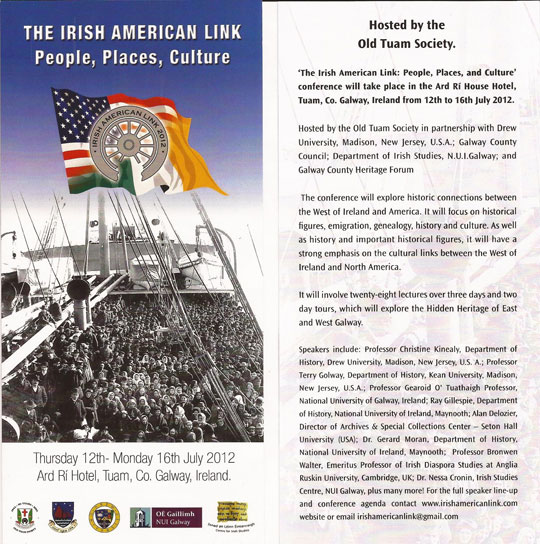 |
|||||||||
|
|
|
||||||||
|
Old
Tuam Society |
|||||||||
 A LOVE of history and a deep interest in their local area in particular led a group of Tuam people to come together over sixty years ago with a view to preserving a record of the town’s illustrious past and to foster and promote that knowledge for the benefit of future generations. Their foresight and vision was, thankfully, appreciated by their successors ever since and the Old Tuam Society is still a thriving organisation. |
|||||||||
| According to an item in The Tuam Herald dated September 26, 1942 the new society was open to “all those who are interested in its aims, namely the preservation and study of the antiquities of Tuam and district.” Young and old were welcome as well as “members of the fair sex.” An invitation was issued to Tuam people scattered far and wide to join the circle for an annual subscription of two shillings and six pence. | |||||||||
|
To cynics of the time
who might have wondered why those good people went to the trouble of
“the preserving and studying of history and the relics of a
barbarous past” as a spokesperson for the society described their
work, the Herald correspondent of the time quoted the late Most Rev.
Dr. Healy, Archbishop of Tuam when he had addressed the same
question at a meeting of the Galway Archaeological Society
previously. Said Dr. Healy: “As to its utility, these studies will not put money in your purse and they are not designed to minister in any way to your sensual enjoyment but there are nobler aims in life than to make money or gratify the senses. Not on bread alone doth man live: he has an intellectual and moral nature higher than the brutes. He has got aspirations and yearnings that mere sensuality can never gratify nor even stifle.” Fine sentiments, expertly expressed but whether they would influence today’s teenagers is debatable. However people in Tuam and its hinterland at the time were, thankfully, only too happy to co-operate with the aims of the fledgling society. Brid Lynch, a remarkable Tuam woman of many talents who is still very active in her local community was a founder member and is one of the the few surviving early members, along with Michael Barrows and Mrs. Mary Gaynor. Brid remembers those early days. “We were a small group of about seven or eight people but we were very dedicated in everything we did whether it was our talks or lectures or going cycling to local places of interest in the area like Abbeyknockmoy, Kilbannon or Ballinrobe. I once remember Lady Molly Cusack-Smith accompanying us on horseback. My good friend Mary Gaynor used to go to the meetings with me to the meetings after choir practice.” Those meetings were always held in the Imperial Hotel, owned by the Guy family at the time. The first O.T.S. president was Dr. Thomas Bodkin Costelloe or Doctor Tom as he was affectionately known. He was one of the main driving forces as was his wife Eibhlín Bean Mhic Choisdealbha who in her own right is still remembered for her marvellous collection of songs and folklore of the area entitled Amhráin Mhuighe Seola. Tuam historian John J. Waldron, whose family owned a shop where the New Brogue pub now stands, was of course another leading light and inspiration. Could it be that his great interest in the town and its environs might be due to the fact that he was born by a remarkable coincidence, on the feast day of St. Jarlath, June 6th 1896. Then, as now, the co-operation of the local paper The Tuam Herald was crucial to the success of the group as it conveyed its activities, news and views to a wide audience. In a 1942 plea to Herald readers the Old Tuam Society outlined its intention to “collect and publish any material concerning the history of Tuam.” The public were asked to “give or loan any old newspapers, periodicals or photographs that may be of local or even national interest that they might have in their possession.” |
|||||||||
|
|
|
|
|||||||
|
|
|||||||||
| Disclaimer | |||||||||
|
|
The information contained in this website is, to the best or our knowledge, true and accurate at the time of publication and is solely for informational purposes. All information on this site is intended to be accurate, complete and timely. Western Webs accepts no liability for any loss or damage howsoever arising as a result of use or reliance on these web pages, or on the information thereon, or in respect of information accessed via any links from the Web pages. Questions regarding content of this web site should be sent to sales@western-webs.com. No information on this site is intended to serve as legal advice. | ||||||||
|
|
|||||||||
|
|
|||||||||
 |
|||||||||